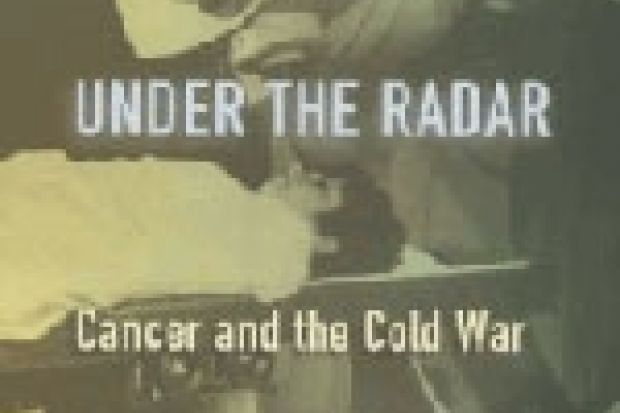It doesn't take a semiotician to recognise our reliance on war metaphors in characterising cancer and our responses to it. In the 1950s, educators and the media frequently portrayed cancer as the quintessential communist foe, a malign infiltrator insinuating itself throughout the body and subverting its natural processes to make war from within. But, as historians on both sides of the Atlantic are beginning to show, the relationship between cancer and warfare has been more than a matter of metaphors, and never more so than in the mid-20th-century United States. In Under the Radar: Cancer and the Cold War, Ellen Leopold draws on this recent academic work in medical history as well as her own research to explore what she calls the "unsavoury intimacy" between American efforts to manage cancer and the armed stand-off between East and West.
This book is at its best in the early chapters, where Leopold anchors her story in the horrifying experience of Irma Natanson. In 1955, this young Kansas homemaker underwent post-mastectomy radiotherapy using a powerful new radiation source, cobalt-60. Ultimately cobalt therapy would be used widely and safely, although its power meant that it could cause side-effects. But when Natanson's doctor offered her a new treatment, he never warned her of potential problems nor told her that he (like most US specialists outside elite centres) had little practical experience with it. She suffered not side-effects but disastrous and crippling injuries - severely burned and ulcerated skin, necrotised ribs and cartilage, and extensive infections - that repeated and expensive surgeries would never repair. She battled for years to have her claim for medical negligence compensated.
Leopold then unpicks the knot of interests and institutions that brought cobalt therapy, originally devised in Canada, to Natanson's hospital in the first place. Anxious to give the atom a friendlier face, the US Government seeded the rapid development of a home-grown radioactive cobalt industry: it promised a steady supply of isotopes for commercial and clinical use, encouraged manufacturers to collaborate with clinicians and physicists in the design of new equipment using cobalt-60, and sponsored conferences to stir up medical excitement about this new technology.
In other words, Leopold's argument is that the military-industrial complex brought in a third partner, medicine, to commercialise the by-products of war as speedily as possible, a process aided by cancer specialists' eagerness to find effective new therapies. This "premature rush to market", she suggests, dampened discussion of this new technology's risks and was thus ultimately to blame for Natanson's devastating (but thankfully rare) experience.
She then connects the alliances that fostered cobalt-60's rapid commercialisation to a far darker military-medical collaboration: the 1950s and 1960s whole-body radiation experiments conducted by clinician-researchers at the Department of Defence's behest. As journalists and the Advisory Committee on Human Radiation Experiments eventually revealed, this work involved terminally ill civilians, often African-American charity patients. These men and women were allowed to think they might receive therapeutic benefit from incapacitating exposures. In fact, they were serving as data points for the US Air Force, which wanted to understand the effects that radiation might have on pilot performance.
The remainder of the book traces what Leopold suggests are similar Cold War efforts to sanitise and exploit atomic energy through medicine. This process was two-pronged. First, the US Government strove to ignore or minimise the real harms done by radiation, most notably by trying to evade legal claims made by Western residents harmed by fallout from nuclear testing. This evasion, she argues, made canny use of epidemiologists' growing emphasis on "lifestyle factors" in the production of disease.
Luckily for the Government and industry, medicine increasingly laid responsibility for cancer at the individual's door, as the same thinking that indicted personal behaviours such as smoking diverted attention - and blame - away from radiation exposure and other man-made, environmentally pervasive carcinogens. Second, the military-industrial complex helped clinician-researchers repackage radiation for more and more medical uses, including mammography. Here Leopold makes perhaps her most debatable claim, that such technologies exemplified and exacerbated a kind of militaristic mindset within American medicine. This, she proposes, sustained a war on cancer that privileged early detection and aggressive therapeutic intervention rather than primary prevention.
Compelling prose renders Under the Radar a readable exploration of the connections between Cold War thinking, politics and institutions, and American medicine's efforts to manage cancer. Leopold makes some of those connections firmly, but others are speculative. This is particularly true in the book's second half, as the focus skips quickly from fallout litigation to the American Medical Association's battle against "socialised" medicine to mammography to the science of risk estimation and chemical carcinogens, and so on. (Leopold seems to acknowledge this, noting that the Cold War response to radioactivity "refuses to submit to a simple story line".) Nevertheless, this breadth of focus makes for a thought-provoking book.
Under the Radar: Cancer and the Cold War
By Ellen Leopold
Rutgers University Press
284pp
£24.50
ISBN 9780813544045
Published 15 December 2008
Register to continue
Why register?
- Registration is free and only takes a moment
- Once registered, you can read 3 articles a month
- Sign up for our newsletter
Subscribe
Or subscribe for unlimited access to:
- Unlimited access to news, views, insights & reviews
- Digital editions
- Digital access to THE’s university and college rankings analysis
Already registered or a current subscriber? Login
